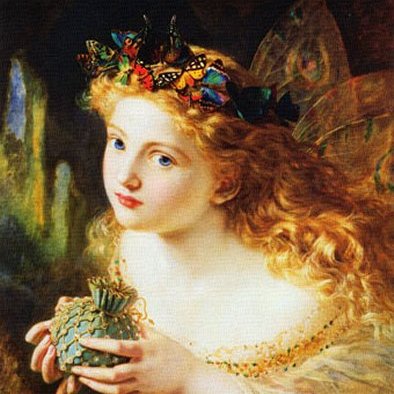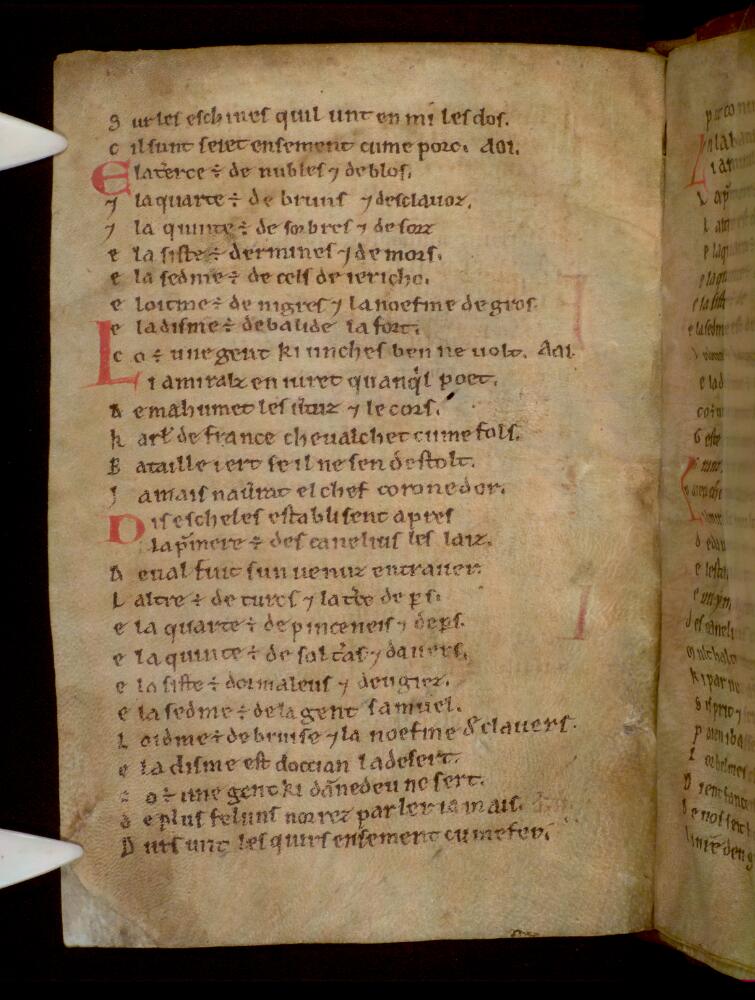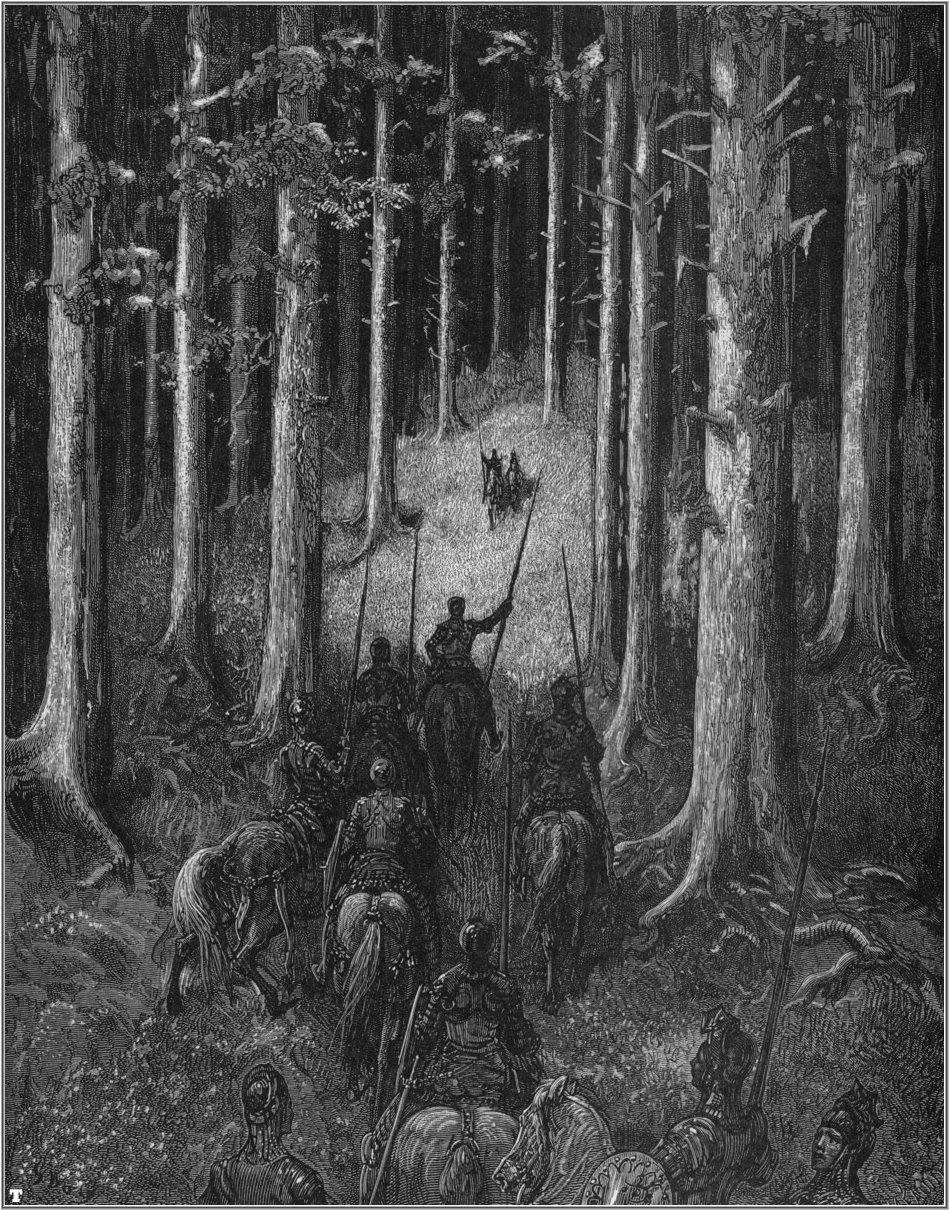|
Doon (lai)
"Doon" is an anonymous Breton lai that tells the story of a knight, Doon, who must pass certain tests to win the hand of a maiden. They marry; but he returns to France alone. He is later reunited with the lady thanks to their grown son, whom he recognizes after dueling him at a tournament. This lai is very similar to "Milun" by Marie de France. Composition and manuscripts "Doon"'s date of composition is estimated around the beginning of the 13th century. The lai is contained one existing manuscript: Paris, Bibliothèque Nationale de France, nouv. acq. fr. 1104, f. 15v, col. 1. This manuscript dates from the end of the 13th or beginning of the 14th century. The text is written in Francien with some Norman and Picard influences. Plot summary "Doon" begins with a beautiful heiress who lives near Daneborc (modern-day Edinburgh). She is very prideful and will not take a husband. All the men in the land try to woo her, but she refuses unless her suitor can travel from Southampton to ... [...More Info...] [...Related Items...] OR: [Wikipedia] [Google] [Baidu] |
Breton Lai
A Breton lai, also known as a narrative lay or simply a lay, is a form of medieval French and English romance literature. Lais are short (typically 600–1000 lines), rhymed tales of love and chivalry, often involving supernatural and fairy-world Celtic motifs. The word "lay" or "lai" is thought to be derived from the Old High German and/or Old Middle German ''leich'', which means play, melody, or song, or as suggested by Jack Zipes in ''The Oxford Companion to Fairy Tales'', the Irish word ''laid'' (song).Zipes, 62 Zipes writes that Arthurian legends may have been brought from Wales, Cornwall and Ireland to Brittany; on the continent the songs were performed in various places by harpists, minstrels, storytellers.Zipes, Jack, ''The Oxford Companion to Fairytales''. Oxford UP. 2009 62-63 Zipes reports the earliest recorded lay is Robert Biker's Lai du Cor, dating to the mid- to late-12th century. The earliest of the Breton lais to survive is probably ''The Lais of Marie de Fra ... [...More Info...] [...Related Items...] OR: [Wikipedia] [Google] [Baidu] |
Yonec
"Yonec" is one of the ''The Lais of Marie de France, Lais of Marie de France'', written in the twelfth century by the French poet known only as Marie de France. ''Yonec'' is a Breton lai, a type of narrative poem. The poem is written in the Anglo-Norman language, Anglo-Norman dialect of Old French in rhyming couplets of eight syllables each. This lai tells the story of a woman who seeks to escape a loveless marriage, and of the child born from the love that she found elsewhere. Plot summary The lord of Caerwent, a rich old man, marries a beautiful young woman. He fears that she will be unfaithful to him, so he imprisons her in a tower and assigns his aged sister to watch over her. As the years go by, she laments her situation and stops taking care of herself, making her beauty fade away. One day, she cries out to God, wishing that she could experience a romantic adventure as she has heard in fairy tales. Suddenly, a dark bird resembling a goshawk appears at her window. The bird tra ... [...More Info...] [...Related Items...] OR: [Wikipedia] [Google] [Baidu] |
Anonymous Lais
Anonymous may refer to: * Anonymity, the state of an individual's identity, or personally identifiable information, being publicly unknown ** Anonymous work, a work of art or literature that has an unnamed or unknown creator or author * Anonymity (social choice), a property of a voting rule, saying that it does not discriminate apriori between voters Organizations * Anonymous (hacker group), the collective name of loosely affiliated individuals who participate in hacktivism Film and television * "Anonymous" (''Australian Playhouse''), an Australian television play * ''Anonymous'' (2011 film), a 2011 film * ''Anonymous'' (TV series), a 2006 Irish television show * "Anonymous" (''CSI''), a 2000 episode of ''CSI: Crime Scene Investigation'' * "Anonymous" (''NCIS: Los Angeles''), a 2010 episode of ''NCIS: Los Angeles'' Music * Anonymous (band), an Andorran band * ''Anonymous'' (Blackbear album) (2019) * ''Anonymous'' (Stray from the Path album) (2013) * ''Anonymo ... [...More Info...] [...Related Items...] OR: [Wikipedia] [Google] [Baidu] |
Medieval French Literature
Medieval French literature is, for the purpose of this article, Medieval literature written in Oïl languages (particularly Old French and early Middle French) during the period from the eleventh century to the end of the fifteenth century. The material and cultural conditions in France and associated territories around the year 1100 unleashed what the scholar Charles Homer Haskins termed the " Renaissance of the 12th century" and, for over the next hundred years, writers, " jongleurs", "clercs" and poets produced a profusion of remarkable creative works in all genres. Although the dynastic struggles of the Hundred Years' War and the Black Death pandemic of the fourteenth century in many ways curtailed this creative production, the fifteenth century laid the groundwork for the French Renaissance. Language Up to roughly 1340, the Romance languages spoken in the Middle Ages in the northern half of what is today France are collectively known as "ancien français" ("Old French") ... [...More Info...] [...Related Items...] OR: [Wikipedia] [Google] [Baidu] |
Medieval Literature
Medieval literature is a broad subject, encompassing essentially all written works available in Europe and beyond during the Middle Ages (that is, the one thousand years from the fall of the Western Roman Empire ca. AD 500 to the beginning of the Renaissance in the 14th, 15th or 16th century, depending on country). The literature of this time was composed of religious writings as well as secular works. Just as in modern literature, it is a complex and rich field of study, from the utterly sacred to the exuberantly profane, touching all points in-between. Works of literature are often grouped by place of origin, language, and genre. Languages Outside of Europe, medieval literature was written in Ethiopic, Syriac, Coptic, Japanese, Chinese, and Arabic, among many other languages. In Western Europe, Latin was the common language for medieval writing, since Latin was the language of the Roman Catholic Church, which dominated Western and Central Europe, and since the Church was v ... [...More Info...] [...Related Items...] OR: [Wikipedia] [Google] [Baidu] |
Anglo-Norman Literature
Anglo-Norman may refer to: *Anglo-Normans, the medieval ruling class in England following the Norman conquest of 1066 *Anglo-Norman language **Anglo-Norman literature * Anglo-Norman England, or Norman England, the period in English history from 1066 till 1154 *Anglo-Norman horse, a breed from Normandy, France *Anglo-Norman Isles, or Channel Islands, an archipelago in the English Channel * CSS ''Anglo-Norman'', a gunboat of the Confederate Navy See also *Cambro-Normans *Normans in Ireland *Scoto-Norman The term Scoto-Norman (also Franco-Scottish or Franco-Gaelic) is used to describe people, families, institutions and archaeological artifacts that are partly Scottish (in some sense) and partly Anglo-Norman (in some sense). It is used to refer to ... {{disamb Language and nationality disambiguation pages ... [...More Info...] [...Related Items...] OR: [Wikipedia] [Google] [Baidu] |
Renaud De Montauban
Renaud de Montauban (; also spelled ''Renaut'', ''Renault'', Italian: ''Rinaldo di Montalbano'', Dutch: ''Reinout van Montalba(e)n'') was a legendary hero and knight which appeared in a 12th-century Old French ''chanson de geste'' known as ''The Four Sons of Aymon''. The four sons of Duke Aymon are Renaud, Richard, Alard and Guiscard, and their cousin is the magician Maugris (French: ''Maugis'', Italian: ''Malagi'', ''Malagigi''). Renaud possesses the magical horse Bayard and the sword Froberge (Italian: ''Fusberta'', ''Frusberta'', French: ''Flamberge''). The story of Renaud was popular across Europe. The tale was adapted into Dutch, German, Italian and English versions throughout the Middle Ages, inspired the Old Icelandic '' Mágus saga jarls'', and also incited subsequent sequels and related texts that form part of the Doon de Mayence cycle of ''chansons''. Renaud, as Rinaldo, is an important character in Italian Renaissance epics, including ''Morgante'' by Luigi Pulci, ''Orl ... [...More Info...] [...Related Items...] OR: [Wikipedia] [Google] [Baidu] |
Chanson De Geste
The ''chanson de geste'' (, from Latin 'deeds, actions accomplished') is a medieval narrative, a type of epic poem that appears at the dawn of French literature. The earliest known poems of this genre date from the late 11th and early 12th centuries, shortly before the emergence of the lyric poetry of the troubadours and trouvères, and the earliest verse romances. They reached their highest point of acceptance in the period 1150–1250.Hasenohr, 242. Composed in verse, these narrative poems of moderate length (averaging 4000 lines) were originally sung, or (later) recited, by minstrels or jongleurs. More than one hundred ''chansons de geste'' have survived in approximately three hundred manuscripts''La Chanson de Roland,'' 12. that date from the 12th to the 15th century. Origins Since the 19th century, much critical debate has centered on the origins of the ''chansons de geste'', and particularly on explaining the length of time between the composition of the ''chansons'' a ... [...More Info...] [...Related Items...] OR: [Wikipedia] [Google] [Baidu] |
Charlemagne
Charlemagne ( , ) or Charles the Great ( la, Carolus Magnus; german: Karl der Große; 2 April 747 – 28 January 814), a member of the Carolingian dynasty, was King of the Franks from 768, King of the Lombards from 774, and the first Holy Roman Emperor, Emperor of the Romans from 800. Charlemagne succeeded in uniting the majority of Western Europe, western and central Europe and was the first recognized emperor to rule from western Europe after the fall of the Western Roman Empire around three centuries earlier. The expanded Frankish state that Charlemagne founded was the Carolingian Empire. He was Canonization, canonized by Antipope Paschal III—an act later treated as invalid—and he is now regarded by some as Beatification, beatified (which is a step on the path to sainthood) in the Catholic Church. Charlemagne was the eldest son of Pepin the Short and Bertrada of Laon. He was born before their Marriage in the Catholic Church, canonical marriage. He became king of the ... [...More Info...] [...Related Items...] OR: [Wikipedia] [Google] [Baidu] |
Matter Of France
The Matter of France, also known as the Carolingian cycle, is a body of literature and legendary material associated with the history of France, in particular involving Charlemagne and his associates. The cycle springs from the Old French '' chansons de geste'', and was later adapted into a variety of art forms, including Renaissance epics and operas. Together with the Matter of Britain, which concerned King Arthur, and the Matter of Rome, comprising material derived from and inspired by classical mythology, it was one of the great European literary cycles that figured repeatedly in medieval literature. Three Matters The Matter of France was one of the "Three Matters" repeatedly recalled in medieval literature. It was contrasted with the Matter of Britain, the legendary history of Great Britain, Brittany and King Arthur; and the Matter of Rome, which represented the medieval poets' interpretations of Ancient Greek and Roman mythology and history. The three names were first used by ... [...More Info...] [...Related Items...] OR: [Wikipedia] [Google] [Baidu] |
Doon De Mayence
Doon de Mayence also known as Doolin de Maience, Doon de Maience or Doolin de Mayence was a fictional hero of the Old French ''chansons de geste'', who gives his name to the third cycle of the Charlemagne romances dealing with the feudal revolts. There is no single unifying theme in the ''geste'' of Doon de Mayence. The rebellious barons are connected by the poets with Doon by fictitious genealogical ties and all are represented as opposing Charlemagne, although their adventures—insofar as they possess a historical basis—generally occur before (or after) his reign. The general insolence of their attitude to the sovereign suggests that Charlemagne is here only a pseudonym for his weaker successors. The tradition of a traitorous family of Mayence (Mainz), which was developed in Italy into a series of stories about criminals, appeared later than the Carolingian cycle. A contributor to the Chronicle of Fredegar states (iv. 87) that the army of Sigebert was betrayed from withi ... [...More Info...] [...Related Items...] OR: [Wikipedia] [Google] [Baidu] |
Tyolet
''Tyolet'' is an anonymous Breton lai that takes place in the realm of King Arthur. It tells the tale of a naïve young knight who wins the hand of a maiden after a magical adventure. Composition and manuscripts The actual date of composition is estimated around the beginning of the 13th century. The lai of ''Tyolet'' is contained in one existing manuscript: Paris, Bibliothèque Nationale de France, nouv. acq. fr. 1104, f. 15v, col. 1. This manuscript dates from the end of the 13th or beginning of the 14th century. The text is written in Francien with some Norman and Picard influences. Synopsis ''Tyolet'' tells the story of a young man who lives in the forest with his widowed mother. Thanks to powers granted to him by a fairy when he was a child, he can summon animals only by whistling. This ability is very useful, as it enables him to put food on the table. One day out in the forest, Tyolet sees a stag and whistles so that it will approach. However, it does not come, so ... [...More Info...] [...Related Items...] OR: [Wikipedia] [Google] [Baidu] |





